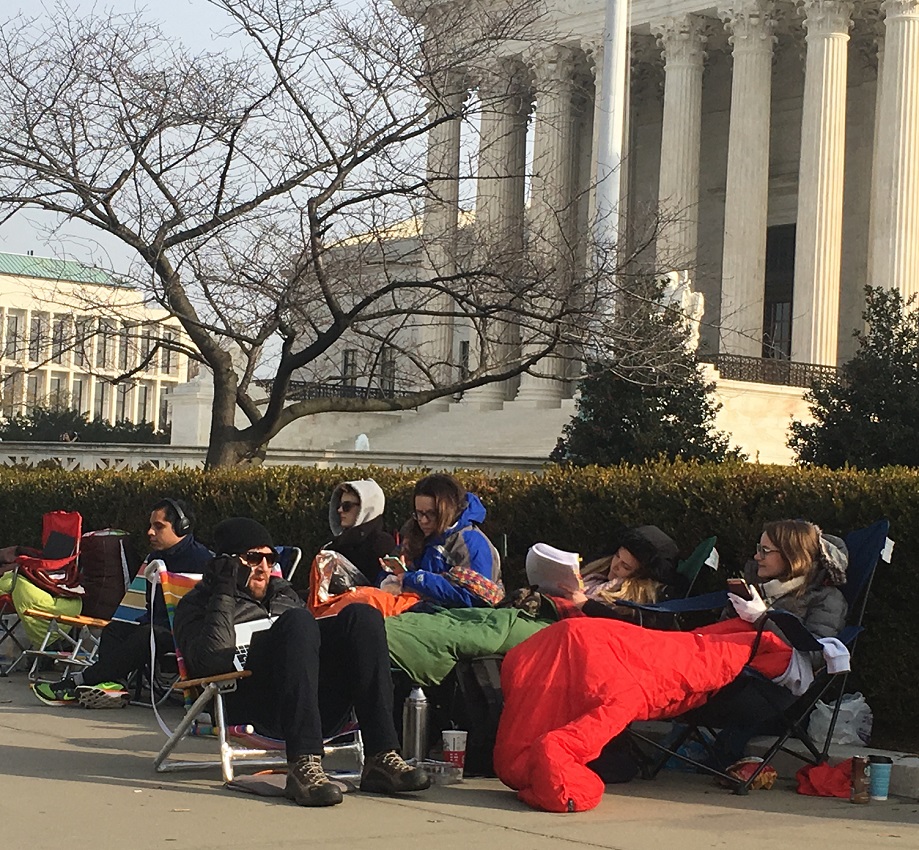Here Are Solutions to Endless SCOTUS Line-Standing
The line for Tuesday’s argument began on Friday. There has to be a better way.

With dozens of frozen souls having waited more than 72 hours now for the chance to hear arguments in Masterpiece Cakeshop, or to hold spots for more well-to-do court-watchers (see photo from Monday, at right), Fix the Court is calling on the justices to design a more modern and elegant solution to courtroom seat scarcity that doesn’t require lawn chairs, sleeping bags and superhuman patience. Several recommendations follow:
1. Same-day audio
Though terribly outmoded, posting audio online the day a case is heard is better from a news and transparency perspective than the current week-end audio – and a fix most justices actually support if you ask them. Twice this term through intermediaries, FTC has tried to convince the justices to post same-day audio: in Gill v. Whitford, FTC worked with a bipartisan group of congressmen on a request and in Masterpiece Cakeshop worked with amici fro
2. Live audio
We learned last year that the court has the capability to livestream audio from its courtroom via the one time it happened: a Nov. 4 Supreme Court Bar meeting honoring Justice Scalia. If the court could do it once, they could do it again.
3. Same-day or live video
The Second, Third and Ninth Circuits allow video and the Seventh is “moving forward with a plan to televise.” Justice Breyer would be pleased to know several foreign courts of last resort, in addition to nearly all state supreme courts, allow video. Most Americans do not realize there’s no video at SCOTUS, and a pilot program, which, incidentally, wouldn’t add $1.5 trillion to the deficit, should be a priority for the congressional committees of jurisdiction.
4. A more equitable way to distribute tickets
Even if broadcast solutions were implemented, citizens would still want to physically be in the courtroom for certain cases, so the court should consider utilizing modern methods of ticket distribution to improve equity. If ticket lotteries can work for Broadway shows about teen angst, Caribbean orphans and pets, they can work for SCOTUS. Even if a lottery created a secondary market, that would still be an improvement over the current situation, where line-standers are often paid thousands of dollars to hold spots for oral argument.
5. Diversify those requesting the fixes
Finally, it’s important to note that some of the most critical high court reforms of the past few years have occurred due to the urging of well-regarded SCOTUS advocates and experts. In 2015 Pam Karlan of Stanford successfully pushed to end the practice of placeholding in the bar line, and also that year Richard Lazarus of Harvard convinced the court to note corrections to slip opinions.
Both reforms remain in effect today, and this release, which is being sent to several repeat advocates, acts as an open invitation to practitioners to work with us to back the types of reforms that would – quite critically, we believe – help raise the regard of the institution in the minds of its 325 million constituents at a time when faith in government is at an all-time low – and, sadly, dropping.
———————
Six photos from this morning of those waiting for Tuesday’s Masterpiece Cakeshop arguments are here: one, two, three, four, f